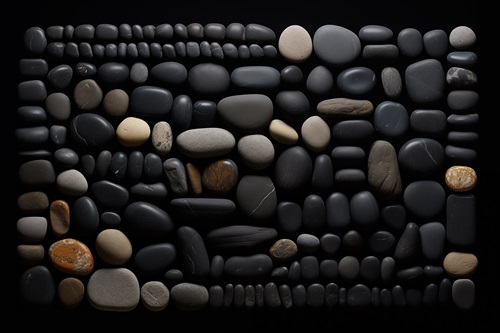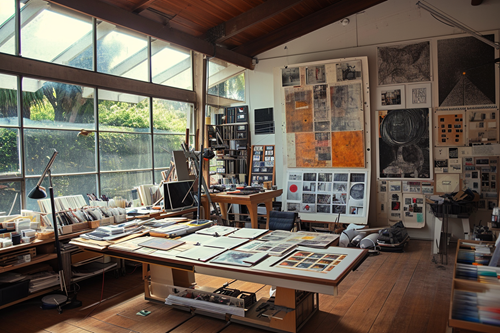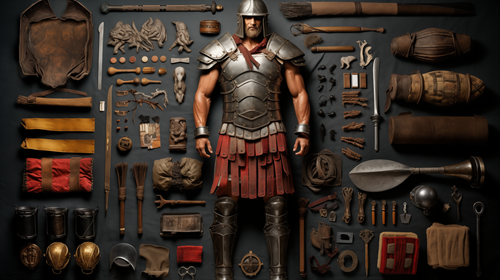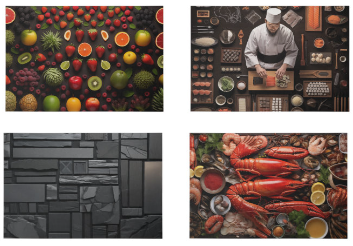
- Details
- Written by: Super User
- Category: Knolling Introduction
- Hits: 414

- Details
- Written by: Super User
- Category: Knolling Introduction
- Hits: 327
Frank Gehry's Santa Monica studio, where Andrew Kromelow worked, played a significant role in the development of the knolling concept. Kromelow was employed as a janitor in this studio, which was engaged in furniture design for Knoll, a renowned US furniture manufacturer known for its boxy, modernist designs. The influence of Knoll's angular designs likely inspired Kromelow's method of organizing tools and objects.
In Gehry’s studio, Kromelow noticed that tools were often left in disarray. He started organizing these tools by laying them out at right angles to each other and to the edges of work surfaces. This method not only enhanced the efficiency of the workspace but also highlighted the aesthetic aspect of these everyday objects, showcasing their forms and shapes distinctly.
Tom Sachs, an artist working in the same studio, was intrigued by Kromelow's systematic approach. He adopted knolling in his own studio and integrated it into his artwork. Sachs is credited with popularizing knolling, turning it into a more widely recognized practice. He formalized the rules of knolling and emphasized its significance in both creativity and organization.
The studio thus became a breeding ground for this innovative method of organization, blending functionality with aesthetics. The concept of knolling has since transcended its original practical purpose, becoming an art form in its own right, celebrated for its simplicity and minimalistic appeal.
- Details
- Written by: Super User
- Category: Knolling Introduction
- Hits: 1209
Andrew Kromelow is a key figure in the history of knolling, although he is not as widely recognized as some other names associated with the concept. Kromelow was a janitor at Frank Gehry's furniture fabrication shop. His contribution to knolling came about as a result of his methodical approach to organizing tools and objects.
Contribution to Knolling
-
Method of Organization: While working at Gehry's studio, Kromelow would meticulously arrange tools and other objects at right angles on a surface, especially at the end of the day. This method not only made the workspace orderly but also made it easier to find tools and components the next day.
-
Term Origin: The term "knolling" itself, however, wasn’t coined by Kromelow. It was named by Tom Sachs, an American contemporary artist, who was inspired by Kromelow’s method of organization. Sachs observed and adopted Kromelow's practice, later incorporating it into his own artistic process and naming it “knolling.”
Impact on Art and Design
-
Influence on Tom Sachs: Sachs' adoption and promotion of knolling in his work brought wider attention to this method. It became a fundamental part of Sachs’ studio practice, emphasizing order and organization in the creative process.
-
Spread Beyond Art: The concept of knolling has since spread beyond the realms of art and design, influencing photography, marketing, and even everyday organization techniques used by individuals.
Legacy
While Andrew Kromelow might not be a household name, his simple yet effective method of organizing tools in Gehry's workshop has had a lasting impact, evolving into a recognized and widely appreciated practice in various fields. The legacy of knolling, as initiated by Kromelow, lies in its promotion of simplicity, order, and clarity, both in artistic expression and in everyday life.

- Details
- Written by: Super User
- Category: Knolling Introduction
- Hits: 984
Flat lay photography is a distinct and increasingly popular style of photography that emphasizes arrangement and composition from a unique overhead perspective. Here's a detailed exploration of its nature, elements, and its relation to knolling:
Definition and Essence of Flat Lay Photography
-
Top-Down Perspective: The core characteristic of flat lay photography is the bird's-eye view. The camera is positioned directly above the subject, offering a distinct, planar perspective. This viewpoint allows every element in the composition to be equally in focus, providing clarity and a sense of organization.
-
Arrangement and Composition: Unlike other photography styles, flat lay emphasizes the meticulous arrangement of objects on a flat surface. This arrangement is key to creating a visually appealing and balanced composition. Photographers carefully consider the placement, spacing, and interaction of each item.
-
Lighting: Flat lay photography often utilizes soft, diffused lighting to reduce shadows and evenly illuminate the subjects. Natural light is commonly preferred, but artificial light sources can be used to maintain consistency in different environments.
-
Background and Surface: The choice of background or surface is crucial. It needs to be flat and usually uniform, allowing the objects to stand out. Textures and colors of the background are selected to complement or contrast with the objects being photographed.
-
Focus on Aesthetics and Theme: Each flat lay tells a story or conveys a theme. Whether it's a collection of travel items, food, fashion accessories, or everyday objects, the arrangement and choice of items are designed to evoke a certain mood or narrative.
-
Use in Various Domains: Flat lay photography is popular in marketing, social media, product display, art, and even in personal photo collections. It offers a clean, organized, and attractive way to showcase items.
Relation to Knolling
-
Knolling as a Subset: Knolling can be considered a subset or a specific approach within flat lay photography. It shares the overhead perspective but has additional distinct characteristics.
-
Methodical Arrangement: Knolling is characterized by its methodical arrangement of objects at 90-degree angles from each other, creating a sense of uniformity and order. This approach is particularly effective in highlighting the shapes and design of the objects.
-
Origin and Application: The term “knolling” originated in the 1980s, attributed to Andrew Kromelow, a janitor at Frank Gehry's furniture fabrication shop. He would arrange tools at right angles on a surface, making them easier to find. This method was later named and popularized by artist Tom Sachs.
-
Utility and Aesthetic: While knolling began as a practical method for organization, it has evolved into an aesthetic choice in photography, particularly in areas like tool organization, product showcasing, and artistic displays.
-
Contrast with Other Flat Lay Styles: Unlike more freeform flat lay arrangements, knolling is defined by its strict geometric precision. However, both styles share the goal of creating visually pleasing and organized compositions from an overhead viewpoint.
In summary, flat lay photography is an artistic and functional style focused on the overhead arrangement of objects. Its relation to knolling lies in the shared perspective and emphasis on arrangement, with knolling being a more structured and geometrically precise subset of the broader flat lay style. Both techniques have found widespread application in various fields, ranging from art to marketing, and continue to evolve with changing trends and creative innovations.

- Details
- Written by: Super User
- Category: Knolling Introduction
- Hits: 814
In today's increasingly cluttered and chaotic world, the art of knolling has emerged as a unique and visually captivating technique for organizing and arranging objects in a precise and orderly manner. Knolling is more than just a method of tidying up; it is a form of artistry and a discipline that celebrates both aesthetics and functionality. In this comprehensive article, we will delve deep into the world of knolling, exploring its origins, principles, techniques, and its influence on various aspects of modern life.
What is Knolling?
Knolling, often referred to as "flat lay" or "flat lay photography," is a technique that involves arranging related objects in parallel or right angles to each other on a flat surface. The goal is to create a visually pleasing and harmonious composition that emphasizes the organization, symmetry, and the relationship between the objects. Knolling can be applied to various fields, including art, design, photography, and even daily life organization.
Origins of Knolling
The term "knolling" was popularized by Andrew Kromelow, a janitor at Frank Gehry's furniture fabrication shop, in the 1980s. Kromelow noticed that the architects and designers working at the shop would organize their tools and materials meticulously, arranging them neatly on their workspaces before commencing their projects. He coined the term "knolling" as a reference to Florence Knoll, a renowned American architect and designer known for her clean and minimalist designs.
The Principles of Knolling
The art of knolling is guided by several key principles:
-
Order and Symmetry: Knolling requires arranging objects with precision and symmetry, creating a balanced and visually pleasing composition.
-
Organization and Accessibility: Knolling makes it easy to locate and access items quickly, making it a practical organizational tool.
-
Aesthetics and Visual Impact: Knolling prioritizes aesthetics, transforming ordinary objects into visually captivating arrangements that tell a story.
Techniques for Knolling
Achieving the perfect knolling arrangement requires careful planning and execution. Here are some essential techniques to master:
-
Selecting the Right Objects: Start by choosing objects that are related in theme, color, or function. This will create cohesion in your knolling composition.
-
Use a Flat Surface: Knolling is typically done on a flat surface like a tabletop or a floor. Ensure it's clean and uncluttered before you begin.
-
Measuring and Aligning: Use a ruler or measuring tape to ensure objects are spaced evenly and aligned perfectly. Attention to detail is crucial.
-
Play with Angles: Experiment with different angles and orientations of objects to find the most visually appealing arrangement.
-
Lighting and Shadows: Pay attention to lighting to create depth and dimension in your knolling composition. Shadows can add drama and interest.
Applications of Knolling
Knolling has found its way into various fields and applications:
-
Photography: Knolling is widely used in product photography and social media content creation to showcase products in an organized and aesthetically pleasing manner.
-
Interior Design: Interior designers use knolling principles to arrange decor items and create visually appealing spaces in homes and businesses.
-
Organization and Efficiency: In daily life, knolling can help individuals organize their workspace, kitchen, or personal belongings for increased efficiency and aesthetics.
-
Art and Creativity: Artists and designers use knolling as a source of inspiration and a method for conceptualizing new ideas.
The Future of Knolling
As society becomes increasingly focused on the aesthetics of organization, the art of knolling is likely to continue evolving. With the rise of social media and digital platforms, knolling has gained popularity as a means of sharing creative and organized content with a global audience. It has also become a source of inspiration for artists, designers, and creators in various fields.
In conclusion, knolling is a fascinating and multifaceted technique that celebrates the marriage of organization and aesthetics. It has a rich history and continues to influence how we perceive and appreciate order and arrangement in the modern world. Whether you're a photographer, designer, or simply someone looking to bring more order and beauty into your life, knolling offers a creative and visually pleasing approach to achieving your goals.
Buy knolling merchandise

